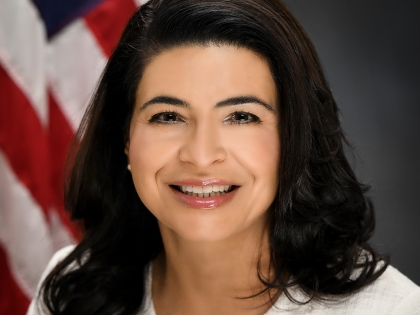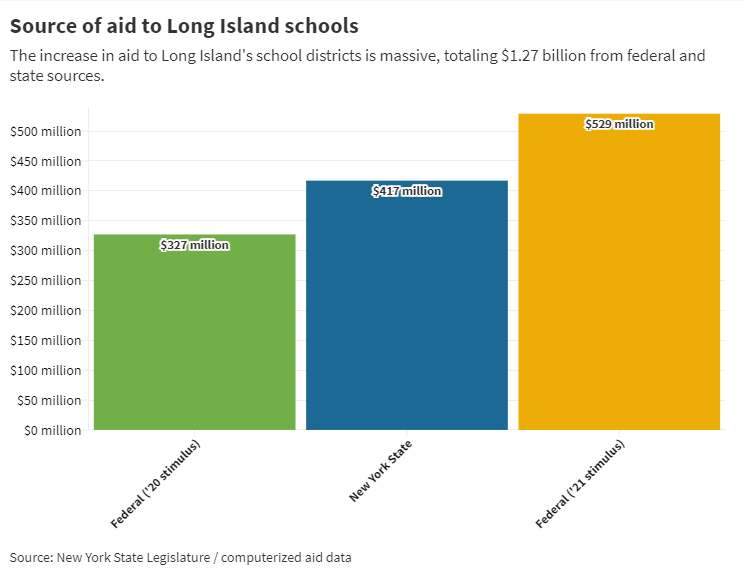
What will the record aid increase to LI schools be used for? Here's a look.

The $1.27 billion in funding, which surprised many local educators with its size and scope, will mean more after-school tutoring, more summer schools and more prekindergarten classes for the Island's 124 districts, officials told Newsday.
"This is a real game-changer for us. We can do so much good for kids," said Robert Troiano, president of Westbury's school board, of money earmarked for that district.
WHAT TO KNOW
-
The increase in aid to Long Island's school districts is massive, totaling $1.27 billion from federal and state sources.
-
It's also historic — the biggest aid expansion ever to the region's schools in dollar terms.
-
The funding is earmarked for improvements ranging from summer learning camps and prekindergartens for students, to greater equalization of finances between districts rich and poor.
Also on districts' agendas are building improvements related to the COVID-19 pandemic — for example, upgraded ventilation systems and cleaning services — along with extra purchases of electronic tablets and expansion of broadband accessibility to aid in online instruction.
Moreover, the inflow of cash makes it easier for districts to reduce taxes included in budget proposals, most of which go to local voters on May 18. Both Westbury and Freeport are calling for tax cuts, for example.
So where are dollars coming from?

For starters, New York State is boosting funding to schools in the Nassau-Suffolk region by $417 million, assisted by higher income taxes on multimillionaires. The additional money, approved by state lawmakers April 7, is three times higher than the typical raise in recent years.
At the same time, the region's districts are receiving another $529 million through a federal stimulus initiative signed by President Joe Biden last month. An additional $327 million has been thrown in from an earlier stimulus approved in December by then-President Donald Trump.
The state aid figure refers to next year's allocation; federal dollars are to be spread over the next two to three years.
Some responses from school officials have been emotional. Troiano told Newsday that he teared up the morning he was informed by State Sen. Anna Kaplan (D-Great Neck) that his 5,000-student district would share in a statewide aid increase geared to the needs of cash-strapped systems.
Other educators, while also enthusiastic, question whether an initiative so sweeping can be managed effectively and sustained over the long haul.
Michael Cohen, a former Brentwood school superintendent and math professor, recalled his reaction several months ago when told of the financial windfall on the horizon.
"As a mathematician, I’ve worked with big numbers, but these just boggle the mind," Cohen said. "The first reaction I had was total shock, this is uncharted territory. And the second question I had was, ‘How are they going to spend the money? Where’s the money going?' "
Federal and state guidelines partly address those questions.
Much of the money is earmarked to deal with student "learning loss" — a nationwide problem resulting from school shutdowns during the pandemic. At the statewide level, other funding will be used to lessen the financial gap between rich and poor districts — a goal that, until recently, was considered virtually unattainable.
Chuck Dedrick, executive director of the New York State Council of School Superintendents, recently declared that the latest cash infusions were "putting our public schools in a vastly better position than we would have dared to hope for last summer or fall."
Here are responses from some Long Islanders who are beginning to feel the impact.
Summer programs grow
For years, the Commack school district offered a summer sports program known as Cougar Camp for grades three through eight, with parents paying fees of about $125 a week.
On June 28, Cougar Camp opens again, but this time for free. On top of that, Commack will open a second free camp on July 26 for grades K-12, with activities ranging from forensic science and robotics to music and creative writing, with academic tutoring also available.
Past years’ enrollments at Cougar Camp numbered in the hundreds. This summer, school officials expect numbers to swell into the thousands, assisted by hundreds of thousands of dollars in federal stimulus money that will pay the full cost of students’ activities and lunches.
Paola Aspromonti, a PTA vice president at Commack Middle School, expects all three of her children — ages 10, 12 and 14 — to participate in her district’s expanded summer programs.
"I think it’s a great thing, just to get the kids out and doing things together with their friends, making new friends," Aspromonti said. "Hopefully, a lot of people will take advantage of it — I’m sure they will."
Under rules of the Biden stimulus package, at least 20% of money earmarked for schools must go to helping students recover from "lost learning." Extra instruction can be provided in various ways, including after-school sessions, extended school days and summer camps.
Commack Superintendent Donald James described his district's summer program as a chance for students to get reacquainted, after months of separation due to the pandemic.
"Parents are excited. Kids are excited. I’m excited," James said.
Freeport also is growing its summer program to accommodate more applicants, after years of using a lottery to determine who would participate in popular enrichment programs. Local administrators expect the number of students signing up for activities such as art and coding to double from the number served in the past.
"I am just elated that they're going to be able to meet the needs of about a thousand students," said Carmen Piñeyro, a former school board president and mother of three.
More pre-K classes
Many school systems also use lotteries to decide which 4-year-olds get to enroll in prekindergarten classes. Northport-East Northport uses this approach, and administrators there said that typically, more than half of applicants for the district's 21 available pre-K slots have to be turned away.
That's about to change.
Northport-East Northport is one of 64 districts on the Island allotted new federal prekindergarten funding. The district, which budgets $67,000 for pre-K this year, is receiving an additional $567,000 for next school year.
Another plus, local officials said, is that the new dollars will pay for full-day programs. In the past, Northport-East Northport could offer only half-day sessions.
Dana Boshnack, the district's assistant superintendent for teaching and learning, expects that the promise of free full-day schooling will persuade more families to sign up. As in the past, children selected will be placed in private local preschools that contract with the district.
"It's going to be exciting not to have to say to people, 'Sorry, you weren't selected through the lottery,'" said Boshnack, now in her fifth year with the district. "It's nice to be able to say 'Yes.' "
Long Island in the past has been the least-funded region in the state for pre-K programs, and only an estimated 10% of 4-year-olds on the Island have access to full-day government-funded programs, early childhood experts reported. By contrast, New York City offers access to all its 4-year-olds.
Last year, Long Island had a total of 8,731 slots available in public prekindergarten programs, according to the office of State Sen. Todd Kaminsky (D-Long Beach). Of those, 3,031 were for full-day programs, and 5,700 for half-day.
The latest wave of funding will add 5,212 full-day slots across the region — a 60% increase, the senator's office said.
"The pandemic has really brought to light how hard it is to be a working parent," Kaminsky said, referring to the difficulty of finding child care. "There's no reason why Long Island working parents shouldn't have access to pre-K when their New York City counterparts have it."
Closing gap between poor, rich
On Long Island, the struggle by low-wealth school districts for a greater share of state funding goes back nearly a half-century, starting with a lawsuit filed by Levittown's district in 1974.
Levittown ultimately lost its case, but the drive for greater equity in school financing persists. The state budget, which was approved April 7, includes an unexpected commitment to funding reform.
In the budget, the state is to boost its biggest school-assistance category known as foundation aid by a total of $4.2 billion over the next three years. Foundation aid helps poorer districts the most, because it concentrates money on students with limited English skills and other disadvantages, while also seeking to ensure that all schools have enough money to provide a "sound basic education."
Obtaining more foundation aid has been a long-term goal of districts such as Brentwood, which filed its own legal complaint in March 2018 with the U.S. Education Department's Office of Civil Rights, contending it had been shortchanged. In October of that year, adult representatives and students from Brentwood, Westbury and other districts that had joined in the legal action underlined their frustrations with a banner-waving demonstration on the steps of a Mineola courthouse.
Still another funding case, filed in 2014 by a statewide coalition known as New Yorkers for Students' Educational Rights, awaits trial in state Supreme Court. It follows up on a previous lawsuit by a Manhattan-based group, the Campaign for Fiscal Equity or CFE, which won a partially favorable ruling from the state's highest court in 2006.
Troiano, Westbury's school board president, said in an interview last week that he broke into tears the morning he received a phone call from Albany, informing him that Westbury had been allotted an extra $7.5 million in foundation aid. Troiano added that Westbury is projected to get another $10 million in 2022-23 and $6.4 million in 2023-24.
"I was blown away — I couldn't believe it, and I still can't," said Troiano, who has served 12 years on Westbury's board.
Among the district's spending goals, Troiano listed ventilation improvements at four elementary schools, the startup of a new reading program, and plans for a new early childhood center.
In Freeport, which received a $10.8 million increase in foundation aid for next year, Superintendent Kishore Kuncham said the district planned to expand summer enrichment programs such as robotics and coding, while also providing a small cut in property taxes.
"I can't tell you how promising the future looks," Kuncham said.
Leaders in some other districts, while also optimistic, said they remained on guard against a potential recurrence of what happened after the 2008 stock market crash and ensuing recession. State lawmakers, who in 2007 had responded to the CFE ruling and committed to statewide school-aid expansion, reversed themselves during the recession and cut back on funding.
"Although we are very happy, we are hoping the state holds true to its promise," said Robert Feliciano, president of Brentwood's school board.



